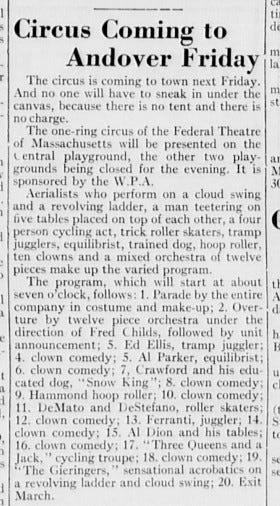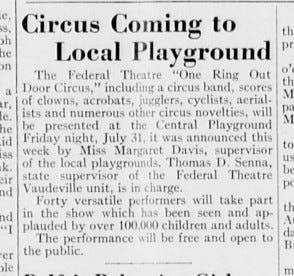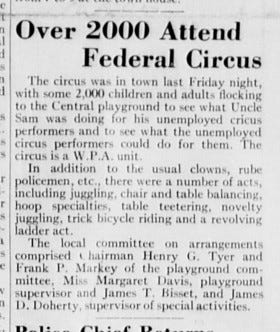One of the things I like best about History Buzz is the research rabbit holes it opens up. If you’re a regular History Buzz reader, you might recall the recent Miscellany Monday’s post on popcorn. As I worked with History Buzz writer Martha Tubinis on her post, I started poking around to see if there is another fun local story that I could share with you. Sure enough, there was.
My rabbit hole started here:
“The Federal Theatre” intrigued me, as did the “Federal Theatre Vaudeville unit.” I knew about the Works Progress Administration and the Civilian Conservation Corps. If I knew about the Federal Theatre Project, I must have forgotten about it.
What was the Federal Theater?
From the Library of Congress, created in 1935,
“The Federal Theatre Project was one of four (subsequently five) arts-related projects called Federal Project Number One, established under the Works Progress Administration (WPA) during Roosevelt's first term.” Its purpose was to create jobs for unemployed theatrical people during the Great Depression.
At one point, the Federal Theatre Project employed around 12,700 people. Nine out of every 10 FTP workers came from the “relief rolls.” About half of those were actors. The other half was writers, designers, musicians, dancers, stage hands, ushers, maintenance works, as well as secretarial and accounting staff. The largest projects were in the major U.S. cities of New York, Los Angeles, and Chicago. Boston had some FTP activity as well.
Federal Theatre Project stage productions included new and classical plays, children’s play, revues and musical comedies, and more. In 1936, 22 sub-projects were created including the circus, the Negro Theatre, motion pictures, and a resident drama program of the Civilian Conservation Corps.1
At its height it created and produced 63,600 performances of 1,200 major theatrical works. It reached audiences of more than 30 million people in cities, towns, and rural areas nationwide, the vast majority of whom had never experienced live theater.2
The circus that came to Andover in July 1936 would take place at the Central Playground, close to downtown Andover.
From the Library of Congress,
Many of the performers, such as Katie Sandwina, known as the world’s strongest woman, had been in the circus for years, but the ranks also included individuals who had unique talents that were not typical of those who performed in traditional theater. Performers included clowns, jugglers, tightrope walkers, cyclists, and aerialists . . . Although few animals performed—(FTP Director) Hallie Flanagan stated “There were no elephants on relief.”
One aerialist was Burt Lancaster.3

Aerialist Burt Lancaster was not listed among the performers who came to Andover in 1936. But, who knows? Maybe Lancaster was among the many performers that evening. Perhaps he was among the “Aerialists who perform on a cloud swing . . .”

A local committee was organized to set up the performance area, stage, arrange for police duty, and make sure ice cream and other refreshments would be available during the free show.
It looks like the circus did not erect a tent. According to the July 31 article a “large area was roped off, and a platform has been set up.”
The Andover event was a success with over 2,000 people attending the “Federal Circus.”4
Thanks for reading!
~Elaine
How about you? Do you have a favorite memory of a visiting the circus? Please leave a comment or ask a question. We love to hear from History Buzz readers!
If you enjoy reading History Buzz, please consider becoming a free or paid subscriber. Paid subscribers help support the research and writing that makes History Buzz possible. Thank you to all our subscribers!
P.S. The editor of the Andover Townsman took advantage of the Federal Circus’ local performance and ran this political cartoon above the “Circus Coming to Local Playground” article.
Cartoonist Alfred Panepinto drew a number of political cartoons against President Franklin D. Roosevelt, the New Deal, and Roosevelt's trade policies. In this cartoon, he lambasted not just President Roosevelt. He also took aim at Roosevelt’s campaign manager and cabinet member, James A. Farley, who was running Roosevelt’s presidential campaign in 1936. A topic I want to explore for History Buzz in the future is how the Townsman reflected the town and citizen responses to the Great Depression of the 1930s.
Alfred Panepinto is better known as the creator of this 1937 Saturday Evening Post cover.
This is what we mean when History Buzz writers talk about research rabbit holes. We never know where our curiosity will take us. Thanks for being along for the ride!
https://www.loc.gov/collections/federal-theatre-project-1935-to-1939/articles-and-essays/wpa-federal-theatre-project/
https://www.loc.gov/exhibits/federal-theatre-project/circus.html
https://mhl.org/historical-newspapers













I did not know that Burt Lancaster was in the circus.
Wow - that is a great rabbit hole! Fascinating! Imagine Burt Lancaster in little ole Andover!